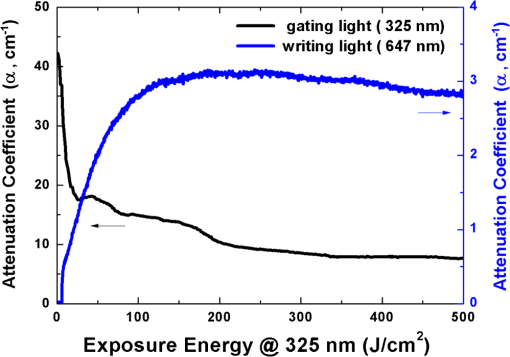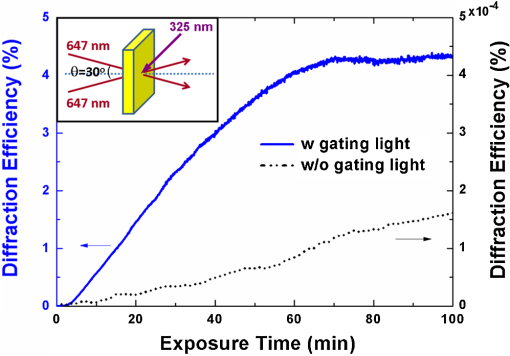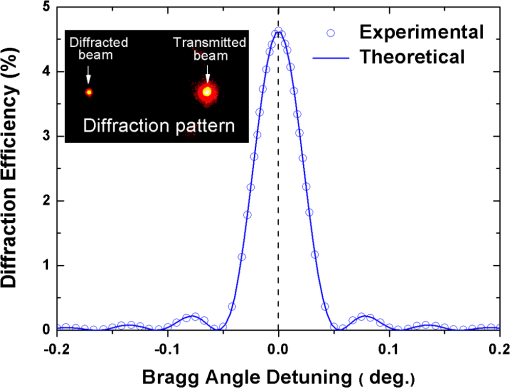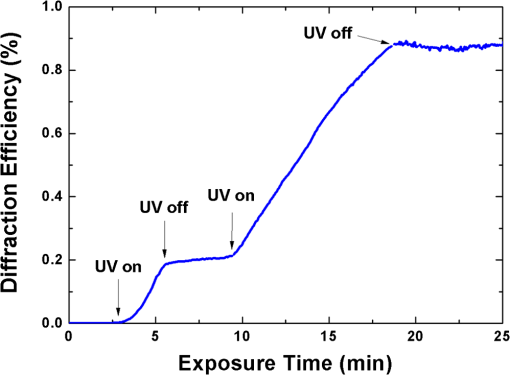|
|
|
Holographic recording using two-wavelength photochemically-based processes, in which the red (even near-infrared) laser is used for recording and the blue (even UV) light was used for optically gating, provides several important features over conventional single-wavelength or two-photon nonlinear recording.1–5 The features include the ability to record holograms with low-intensity and/or longer-wavelength lasers, nondestructive readout before the recording medium reaches saturation, as well as the ability to do selective recording by gating the sensitivity of the medium optically. If these features were combined with volume holography, one could have more freedom for designing optical systems and/or creating innovative ideas for applications. One of the particularly successful examples is optical fixing in doubly doped crystals with two photorefractive centers for the holographic data storage.6 Recently, thick phenanthrenequinone-doped poly(methyl methacrylate) (PQ/PMMA) photopolymer materials have attracted intense research interest because this material possesses not only high optical quality but also negligible light-induced shrinkage.7–9 In this paper, we experimentally demonstrate the possibility of performing two-wavelength holographic recording in 2 mm thick PQ/PMMA. It may be able to open a new window for photopolymer on different applications of optical information, such as data storage, communication, and holographic imaging.3–5 The first demonstration of two-wavelength holography in photopolymer was made by Bjorklund et al. in 1981,1 who proposed to utilize a photosensitive dye with four-level energy schemes with cascade-excited metastable intermediate levels for performing two-wavelength recording. They successfully demonstrated holographic recording in a 200 μm thick carbazole dissolved in PMMA thin film. Later on, Brauchle et al.2 of the same group reported their results with 11% diffraction efficiency on 400 μm photopolymer consisting of an -diketone dissolved in a poly-cyanoacrylate host. More recently, in 2007, Hirabayashi et al.5 reported the two-wavelength holographic recording on a 25 μm thin layer photopolymer TP-1G (Daiso Co., Ltd.) co-doped with two-color-photosensitive dye, bis(silyl)pentathiophene and photo-initiator, 2,2-dimethoxy-2-phenylacetophenone. In general, those materials consist of photosensitive dye with four energy level systems dissolved in a polymer host. In terms of chemical formula, the PQ is -diketone based derivatives, so that using the same idea, it is possible to perform two-wavelength holographic recording in PQ/PMMA. Thick PQ/PMMA samples studied in this work were prepared by two-step thermo-polymerization method.7 We dissolved 0.7 wt% of photosensitive dye, PQ and 1 wt% of thermal initiator, azobisisobutyronitrile molecules into the liquid monomer, MMA. The solution was stirred at 30°C for 24 h, until it became viscid. The solution was then poured into a glass mold, baked at 45°C for 72 h and became a self-sustained solid block with dimension of . The sample can be removed from the mold for optical and holographic testing. The UV-VIS spectrum of the prepared sample (as shown in Ref. 7) indicates two characteristic absorption peaks of the PQ molecules in the spectral range shorter than 450 nm. The sample is almost transparent as the wavelength is longer than 540 nm. Thus, the 325 nm light source is selected as gating light, which approaches the peak of the transition absorption to excite material into a metastable intermediate state for producing absorption in the red spectral range to perform holographic recording.10 For recording, laser beam with wavelength of 647 nm is chosen. The dynamics of light-induced absorption change is then tested. The transmittance of the sample at 647 nm was probed by use of a weak beam from a laser under illumination with additional 325 nm beam from He-Cd laser simultaneously. Figure 1 shows the temporal response of absorption coefficients (, ) of the sample as a function of the exposure energy of gating light. It is seen that the absorption at 647 nm immediately grows as the gating beam is turned on, and reaches saturation at as the energy density reaches to . On the other hand, the absorption at 325 nm gradually decreases from to . The curve becomes saturated at the exposure energy density of , indicating the sample to be bleached. These results suggest that the hologram can be recorded most efficiently in PQ/PMMA as the exposure energy of gating light reaches . This information is useful for designing the two-wavelength holographic experiments in PQ/PMMA. Fig. 1The dynamics of light-induced attenuation coefficients (, ) for a 2 mm thick PQ/PMMA (black curve: gating light at 325 nm; blue curve (online): recording light at 647 nm).  Next we perform the holographic experiments. Two 647 nm -polarized beams were used to write gratings in a two-wave beam interference setup in transmission geometry. The schematic diagram is shown in the inset of Fig. 2. The intensity of each recoding beam was about and the writing angle between two beams was 30-deg outside the sample. The grating growth was probed at real time with a low power third beam, coming from the same laser source. For more efficient recording, a cw 325-nm laser beam with intensity of illuminated sample simultaneously during holographic recording. The temporal response of the diffraction efficiency is shown in Fig. 2. For comparison, diffraction dynamics of a hologram recorded in the sample without UV gating is also included and shown with a black dashed curve. It is seen that the material sensitivity of holographic recording at 647 nm is dramatically enhanced with UV gating light. The diffraction efficiency gradually grows and saturates at the value of . Meanwhile, the sample is nearly inactive to the red without gating. The saturated value of the dashed curve approaches , which is times less than that with gating. Fig. 2Holographic dynamics of the two-wavelength holographic recording in a 2 mm thick PQ/PMMA sample (insert: schematic diagram for optical setup).  In order to demonstrate the ability to do selective recording in the PQ/PMMA sample by optical gating, which is important for providing the capability of nondestructive readout of the recorded hologram, we perform the second holographic experiment. During the recording, the gating laser was switched on and off alternately. The result is shown in Fig. 3. It can be seen that during the interval as the gating beam was blocked (UV off), diffraction efficiency remained almost constant, indicating no hologram growth was observed. At the moment as the gating beam was turned on (UV on), the diffraction efficiency immediately began to grow rapidly with time. Additionally, as illustrated in Fig. 3, we have blocked the gating beam at , and no significant growth and decay of hologram were observed for exposure time as long as 28 min. In a subsequent experiment, we blocked one of the recording beams, and the hologram was exposed to uniform 647 nm radiation with intensity of for up to 24 h. We found out that there was no significant change in diffraction efficiency of the hologram, which demonstrates the nondestructive readout capability of the hologram. These results indicate that the gating light at 325 nm is very efficient to perform optical gating of material sensitivity to achieve two-wavelength holographic recording. After holographic recording, the Bragg selectivity curve of the hologram was measured by rotating the sample mounted on a rotational stage. Figure 4 shows a typical curve for a hologram with diffraction efficiency. It can be seen clearly that the hologram has a sinc-squared selectivity curve as expected for a uniform 2 mm thick hologram. It is because of that the absorption of sample at 647 nm is too small to generate a smoothing of secondary lobes of sinc-squared curve in the angular response. On the other hand, we were able to observe a uniform diffracted beam spot in experiments (shown in the inserted picture in Fig. 4). This result suggests a good volume hologram characteristic because the high-bandwidth hologram can be reconstructed completely. Fig. 4The Bragg selectivity curve for a 2 mm thick sample. The symbols represent measured results, and the curve is theoretically calculated by using the Kogelnik’s coupled wave equation (insert: picture of diffraction pattern).  In conclusion, we have successfully performed two-wavelength holographic recording in PQ/PMMA photopolymers. The experimental results show the maximum diffraction efficiency obtained was for a 2 mm thick PQ/PMMA photopolymer. A clear sinc-squared Bragg selectivity curve has been obtained. Although the diffraction efficiency is not optimized yet or as high as that of a hologram recorded by single green wavelength,7–9 these results indicate our PQ/PMMA material to be attractive for volume holographic applications with capabilities of two-wavelength recording. AcknowledgmentsFinancial support by National Science Council, Taiwan under contracts # NSC 100-2112-M-009 -005 is gratefully acknowledged. ReferencesG. C. Bjorklundet al.,
“Two-photon holography with continuous-wave laser,”
Opt. Lett., 6
(4), 159
–161
(1981). http://dx.doi.org/10.1364/OL.6.000159 OPLEDP 0146-9592 Google Scholar
C. Brduchleet al.,
“Two-photon holographic recording with continuous-wave lasers in the 750–1100-nm range,”
Opt. Lett., 7
(4), 177
–179
(1982). http://dx.doi.org/10.1364/OL.7.000177 OPLEDP 0146-9592 Google Scholar
B. Kippelenet al.,
“Infrared photorefractive polymers and their applications for imaging,”
Science, 279
(5347), 54
–57
(1998). http://dx.doi.org/10.1126/science.279.5347.54 SCIEAS 0036-8075 Google Scholar
A. S. Dvornikovet al.,
“Materials and systems for two photon 3-D ROM devices,”
IEEE Trans. Compon. Packag. Manuf. Tech.-Part A, 20
(2), 203
–212
(1997). http://dx.doi.org/10.1109/95.588575 IMTAEZ 1070-9886 Google Scholar
K. Hirabayashiet al.,
“Multilayer holographic recording using a two-color-absorption photopolymer,”
Appl. Opt., 46
(35), 8402
–8410
(2007). http://dx.doi.org/10.1364/AO.46.008402 APOPAI 0003-6935 Google Scholar
K. BuseA. AdibiD. Psaltis,
“Non-volatile holographic storage in doubly doped lithium niobate crystals,”
Nature, 393
(18), 665
–668
(1998). NATUAS 0028-0836 Google Scholar
Y. N. HsiaoW. T. WhangS. H. Lin,
“Analyses on physical mechanism of holographic recording in phenanthrenequinone-doped poly(methyl methacrylate) hybrid materials,”
Opt. Eng., 43
(9), 1993
–2002
(2004). http://dx.doi.org/10.1117/1.1774196 OPEGAR 0091-3286 Google Scholar
D. Yuet al.,
“Improvement of holographic thermal stability in phenanthrenequinone-doped poly(methyl methacrylate-co-methacrylic acid) photopolymer,”
Opt. Eng., 50
(9), 085803 (5 pp)
(2011). http://dx.doi.org/10.1117/1.3614567 OPEGAR 0091-3286 Google Scholar
U. V. Mahilnyet al.,
“Phase hologram formation in highly concentrated phenanthrenequinone-PMMA media,”
J. Opt. A: Pure Appl. Opt., 10
(8), 085302 (7pp)
(2008). http://dx.doi.org/10.1088/1464-4258/10/8/085302 JOAOF8 1464-4258 Google Scholar
J. ChiltonL. GieringC. Steel,
“The effect of transient photoproducts in benzophenone-hydrogen donor systems,”
J. Am. Chem. Soc., 98
(7), 1865
–1870
(1976). http://dx.doi.org/10.1021/ja00423a036 JACSAT 0002-7863 Google Scholar
|


